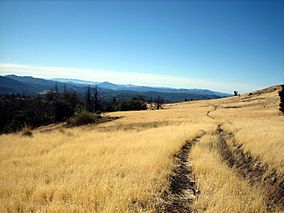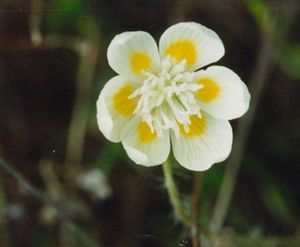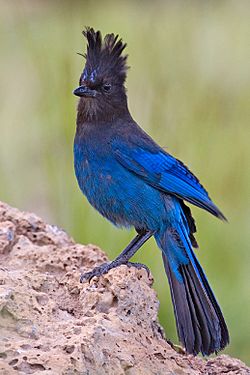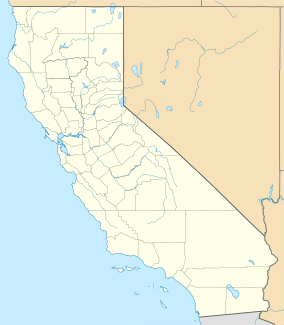Cuyamaca Rancho State Park facts for kids
Quick facts for kids Cuyamaca Rancho State Park |
|
|---|---|

The West Mesa Trail in Cuyamaca Rancho State Park
|
|
| Location | San Diego County, California, United States |
| Nearest city | San Diego, California |
| Area | 24,693 acres (99.93 km2) |
| Established | 1933 |
| Governing body | California Department of Parks and Recreation |
Cuyamaca Rancho State Park is a large state park in California, United States. It's about 40 miles (64 km) east of San Diego in the Cuyamaca and Laguna Mountains. The park covers about 26,000 acres (11,000 ha).
You'll find beautiful pine, fir, and oak forests here. There are also open meadows and clear streams. This is because the park is quite high up in the mountains compared to the land around it. Cuyamaca Peak, which is 6,512 feet (1,985 m) tall, is inside the park. It's the second-highest point in San Diego County.
The park has many fun things to do. You can explore trails for hiking, horseback riding, and mountain biking. There are also different kinds of campgrounds for families, groups, and even for people with horses. You can also visit an exhibit at the old Stonewall Mine, which used to be a gold mine.
Many animals live in the park. You might see mountain lions, so it's important to know how to stay safe around them. The park is also home to many other mammals, birds, reptiles, and amphibians.
In 2003, a big wildfire called the Cedar Fire caused a lot of damage to the park. It was closed for several months. Even though much of the forest burned, the park has reopened. The plants are now growing back, and nature is healing itself.
Contents
What is the Geology of Cuyamaca Rancho State Park?
Cuyamaca Rancho State Park is part of the Peninsular Ranges. These mountains stretch from north of the park all the way down to the tip of Baja California. This area is very active with earthquakes. The mountains here are like a huge raised plateau. It's separated from the Colorado Desert to the east by a large crack in the Earth called the Elsinore Fault Zone. Over millions of years, the land here has been pushed up thousands of feet.
You can find many types of rocks in the Cuyamaca area. Some common ones are schist, gneiss, and quartzite, especially near the Stonewall Mine. Most of the rocks you see in the park are igneous rocks. These include granodiorite, which makes up Stonewall Peak, and gabbro, which forms Cuyamaca Peak. As these rocks break down, they create the red, coarse soil found throughout the park. Gabbro makes a darker red soil than granodiorite.
Gold is a natural element often found near granite rocks. This is because gold forms as hot, melted rock cools down. Gold is often found with quartz. In the Cuyamaca area, gold is linked to a rock called Julian Schist. Miners, like those at the Stonewall Mine, would follow veins of gold into the rock. Most streams in the park have tiny bits of gold because it's always being washed out of the rocks by rain and water.
What Plants Grow in Cuyamaca Rancho State Park?
The park's average height of nearly 5,000 feet (1,500 m) allows many different trees to grow. This is special for Southern California, which is usually very dry.
What Kinds of Trees Are There?
You can find many types of conifer trees here. These include the white fir, incense cedar, Coulter pine, Jeffrey pine, sugar pine, and ponderosa pine.
There are also many broadleaf trees. Some examples are the white alder, Arizona ash, California sycamore, Fremont cottonwood, coast live oak, canyon live oak, Engelmann oak, California black oak, interior live oak, oracle oak, and red willow.
What Kinds of Shrubs Are There?
The park has many large shrubs, which are usually 4 to 15 feet (1.2 to 4.6 m) tall. These include chamise, different types of manzanita (like Eastwood, Cuyamaca, and Mexican manzanita), and various mountain lilacs. Other large shrubs are mountain mahogany, creek dogwood, Parish goldenbush, yerba santa, Parish burning bush, toyon, California barberry, laurel sumac, hollyleaf cherry, western chokecherry, scrub oak, coffeeberry, western azalea, white sage, and elderberry.
Smaller shrubs, usually 1 to 4 feet (0.3 to 1.2 m) tall, also grow here. These include California buckwheat, Wright's buckwheat, chaparral honeysuckle, California rose, creeping sage, snowberry, and poison oak.
What Wildflowers Can You See?

The park is home to many beautiful wildflowers that bloom at different times of the year.
| Early Season | Middle Season | Late Season |
|---|---|---|
| milkmaids (Cardamine californica) | purple nightshade (Solanum xanti) | penstemon (Penstemon spp.) |
| California peony (Paeonia californica) | monkeyflower (Mimulus spp.) | locoweed (Astragalus spp.) |
| goldfields (Lasthenia spp.) | mule's ears (Wyethia helenioides) | cudweed (Pseudognaphalium californicum) |
| creamcups (Platystemon californica) | milkweed (Asclepias spp.) | thistle (Cirsium occidentale) |
| checkerbloom (Sidalcea spp.) | wallflower (Erysimum spp.) | Indian paintbrush (Castilleja spp.) |
| splendid Mariposa lily (Calochortus splendens) | golden bowl Mariposa lily (Calochortus concolor) | California fuchsia (Epilobium canum) |
| tidytips (Layia spp.) | virgin's bower (Clematis lasiantha) | goldenrod (Solidago spp.) |
| golden yarrow (Eriophyllum confertiflorum) | yarrow (Achillea millefolium) | |
| columbine (Aquilegia spp.) | Humboldt's lily (Lilium humboldtii ssp. ocellatum) | |
| baby blue eyes (Nemophila menziesii) | ||
| purple lupine (Lupinus polyphyllus) | ||
| goldenstars (Bloomeria crocea) |
What Animals Live in Cuyamaca Rancho State Park?


You'll often see certain mammals in Cuyamaca Rancho State Park. These include the southern mule deer, coyote, California ground squirrel, Merriam's chipmunk, black-tailed jackrabbit, brush rabbit, and Audubon's cottontail rabbit. While cougars (mountain lions) live here, they are rarely seen.
About 200 different kinds of birds have been recorded in the park. Some common birds that live here all year or visit are the wild turkey, acorn woodpecker, Nuttall's woodpecker, northern flicker, Steller's jay, western bluebird, white-breasted nuthatch, mountain chickadee, American robin, red-tailed hawk, and red-shouldered hawk. Birds that visit in the summer or during migration include the black-headed grosbeak, Baltimore oriole, ash-throated flycatcher, western wood pewee, house wren, several types of warblers, and the lesser goldfinch.
The park is also home to various amphibians and reptiles. You might find the canyon tree frog, Pacific tree frog, red-legged frog, and western toad. Snakes include the common king snake, gopher snake, California mountain kingsnake, racer, striped racer, and western garter snake.
What is the History of Cuyamaca Rancho State Park?
The history of Cuyamaca Rancho State Park goes back thousands of years. It includes the time of early humans and the California Gold Rush.
Who Lived Here First?
Native Americans have lived in this area for at least 7,000 years. You can still find signs of their ancient villages and summer camps in the park. These include bedrock mortars used for grinding food. The name "Cuyamaca" itself comes from the Kumeyaay people. They called this place Ah-Ha Kwe-Ah Mac, which means "the place where it rains." This was important in dry Southern California.
The Kumeyaay people traditionally lived in a large area. This stretched from San Diego east through the Cuyamaca and Laguna Mountains. It went all the way to the Salton Sea and south into Mexico. A typical group would live within about 20 miles (32 km) of their winter home. Today, there are twelve Kumeyaay tribes officially recognized by the government in San Diego County.
How Did the 19th Century Change the Area?
The park is located on land that was part of a Mexican land grant called Rancho Cuyamaca in 1845. When gold was discovered in Julian in 1869, things changed forever for the Kumeyaay people. New governments and settlers arrived. Diseases spread, and the Kumeyaay's traditional way of life was disrupted. In 1875, they were forced off their ancestral lands.
The Stonewall Mine opened in 1870. This led to the creation of a busy town called Cuyamaca City. The mine was most active between 1886 and 1891, employing over 200 workers. In 1889, the Cuyamaca Dam was finished. The Stonewall Mine closed for good in 1892 after losing a lot of money.
How Did the Park Become a State Park?
In 1923, a man named Ralph Dyar bought the Cuyamaca Rancho. He built a summer home there. In 1933, he sold his land to the state of California. This is how Cuyamaca Rancho State Park was created.
Today, the park is over 26,000 acres (110 km2) of protected land. It helps protect wildlife, water sources, important historical sites, and unique plants. About half of the park is set aside as a wilderness area, meaning it is kept as wild as possible.
Cuyamaca Rancho State Park Interpretive Association
The Cuyamaca Rancho State Park Interpretive Association (CRSPIA) helps the park. They also support Palomar Mountain State Park. Their main goal is to make visitors' experiences better through education and special activities.
CRSPIA raises money and supports educational programs. They also help the park's volunteer groups. These groups include volunteers who help visitors, those who help with horses, mountain biking, and trail maintenance.
Most of the money CRSPIA gets from the public goes directly to park programs. They earn money from a gift shop and bookstore, selling firewood, and membership fees. They also hold different fundraising events. Before the 2003 Cedar Fire, their income was about $40,000 per year. Members receive a monthly newspaper called The Stonewall Sentinel.
The Cedar Fire in 2003 destroyed the park's museum, gift shop, and bookstore. All their items were lost. However, a temporary building has been set up. It now offers these services to park visitors once again.
|




